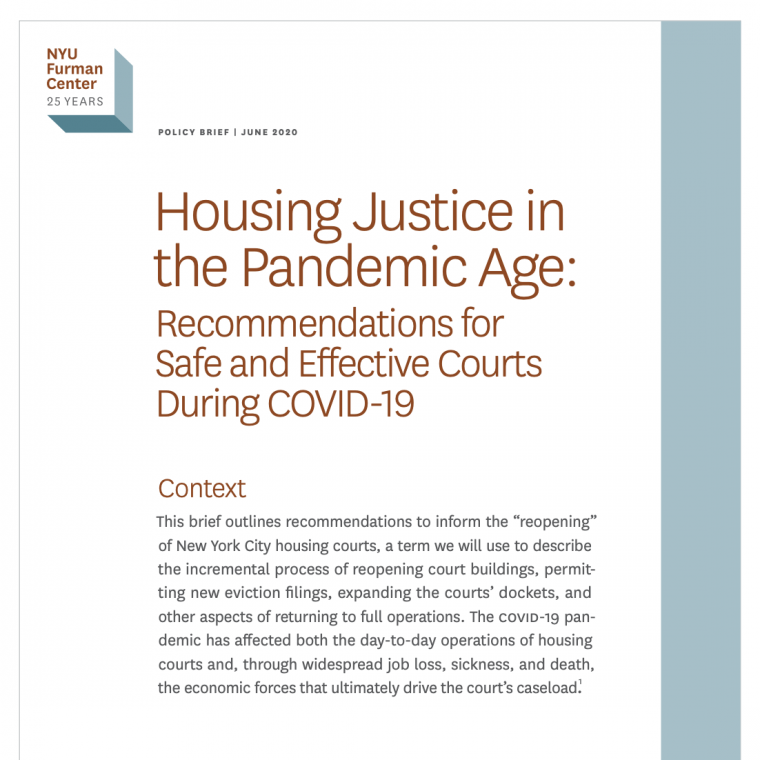
Housing Justice in the Pandemic Age

In the wake of the pandemic, New York State housing courts shut down in early March. Governor Cuomo’s “New York State on Pause” executive order as well as internal directives prevented new eviction filings through June 20, and since then limitations on new filings have been gradually eased. These limitations included the suspension of evictions and residential foreclosures. Housing courts across the state have reopened, posing greater risk of increased evictions and COVID-19 transmission. There are several safety measures policymakers should consider to reduce this risk. Read our full brief, Housing Justice in the Pandemic Age: Recommendations for Safe and Effective Courts During COVID-19.
Housing court faced cultural and procedural challenges in its day-to-day operations before the pandemic. The outbreak of COVID-19 both exacerbated existing problems and added new ones.
To address these challenges, NYU Furman Center Legal Fellow Sophie House provides a framework for the reopening of New York City housing courts, emphasizing four main objectives:
- Prioritize public health and safety;
- Preserve stability for tenants and landlords;
- Ensure racial equity and accessibility;
- Build a foundation that ensures due process.
- Prioritize public health and safety
This the most pressing consideration concerning the reopening of housing courts. Housing courts see thousands of visitors on a daily basis. The infrastructure of most court buildings does not support social distancing. Beyond the physical court proceeding, resuming evictions will result in increases in the homeless population, posing a greater risk of COVID-19 transmission. Research demonstrates that Black and Hispanic populations will be disproportionately harmed by the reopening of housing courts. To avoid these outcomes, courts should consider temporarily relocating to larger spaces, such as convention centers, that will allow for social distancing.
- Preserve stability for tenants and landlords
Eviction has been proven to have a harmful financial and psychological impact on tenants. COVID-19 exacerbates these impacts as well the public health risk for tenants displaced to shelters. Reopening of courts also poses challenges for landlords. The backlog of cases facing courts places financial stress on landlords responsible for maintaining their properties, paying mortgages, and paying property taxes.
Rental assistance could help tenants and landlords avoid housing court, by providing the necessary stability to prevent evictions and foreclosures. Given the budget constraints facing the city and state, rental assistance will likely require federal support. Policymakers should consider the most effective channels of funding to provide rental assistance as well as the agencies best equipped to administer it. These measures will help landlords and tenants meet their needs without the use of the housing courts.
Alternative dispute resolution using methods like mediation is another option to consider instead of court. This past week, the City announced the launch of a mediation program targeted to tenants without legal representation in communities hit hardest by the pandemic.
Elimination of possessory judgments for non-payment evictions is a possible step, working within the court system to reduce the evictions. This course of action would entitle landlords to monetary judgments for non-payment of rent. This measure might have negative externalities such as increased tenant debt and reluctance on the part of landlords to rent to tenants without the ability to evict them.
Courts should be thoughtful regarding the order in which they hear cases. Housing courts address cases in chronological order which, while prioritizing the duration of lost rental income, is an imperfect proxy to address landlord financial distress.
- Ensure racial equity and accessibility.
Communities of color experienced disproportionate eviction and overrepresentation in shelters rates prior to the pandemic. These communities have experienced higher infection rates from COVID-19. Despite evictions trending downward in the past five years rates remain highest in areas with the greatest shares of Black and Hispanic residents. The most effective way to prevent existing inequalities from increasing homelessness in communities of color is to keep cases out of housing court.
To achieve these goals policymakers should track geographic disparities in eviction and target policies accordingly. Housing courts can further reduce disparities by centering accessibility with virtual hearings. Lastly, housing courts should make efforts to promote language accessibility by using interpreters in housing proceedings and producing resources in multiple languages.
- Build a foundation that ensures due process
Housing court has several features that undermine due process. The “hallway culture” and imbalance in representation rates are longstanding challenges. In light of the pandemic, more tenants and landlords are facing hardships that necessitate due process protections, especially as courts transition to virtual hearings. Courts must ensure parties receive notice of all filings and deadlines as well as have access to necessary documents, technology, and representation. The Universal Access to Counsel program is currently being rolled out; it remains to be seen how COVID-19 will impact the program’s deployment.
At minimum the Office of Court Administration must ensure they provide prominent, plain-language guidance for tenants and landlords about electronic filing procedures, remote hearing protocols, dates of scheduled hearings, and process for obtaining representation through their existing website and COVID-19 hotline.
Housing court faces both challenges in opportunities to address new to address disparities, contribute to public health, and replace old and ineffective systems with better solutions. As the Senate debates a relief bill over the next two weeks we are confident that swift action can help landlords and tenants avoid the use of housing court benefiting both parties, the court system, and public health.


